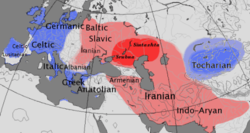Italic languages
The Italic languages are a branch of the Indo-European language family. They were first spoken in Italy, and their main language was Latin, which eventually turned into the Romance languages that are spoken today. The Roman Empire spread Latin to much of Western Europe. Today, the main Italic languages spoken are Spanish, French, Portuguese, Italian, and Romanian. There were other branches of Italic languages besides those that came from Latin, but all of them are now extinct.
| Italic | |
|---|---|
| Geographic distribution: | Originally the Italian peninsula, parts of today's Austria and Switzerland, today southern Europe, Latin America, Canada, and the official languages of half the countries of Africa. |
| Linguistic classification: | Indo-European
|
| Proto-language: | Proto-Italic |
| Subdivisions: |
Latino-Faliscan (including Romance)
Osco-Umbrian (Sabellic)
|
| ISO 639-5: | itc |
Italic Languages Media
Main linguistic groups in Iron-Age Italy and the surrounding areas. Some of those languages have left very little evidence, and their classification is quite uncertain. The Punic language brought to Sardinia by the Punics coexisted with the indigenous and non-Italic Paleo-Sardinian, or Nuragic.
Map showing the approximate extent of the centum (blue) and satem (red) areals
References
- ↑ Prósper, Blanca Maria; Villar, Francisco (2009). "Nueva Inscriptión Lusitana Procedente de Portalegre". EMERITA, Revista de Lingüística y Filología Clásica (EM). LXXVII (1): 1–32. Retrieved 11 June 2012.
- ↑ Villar 2000.

